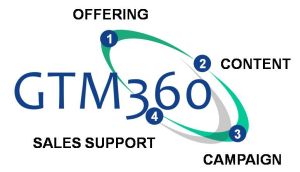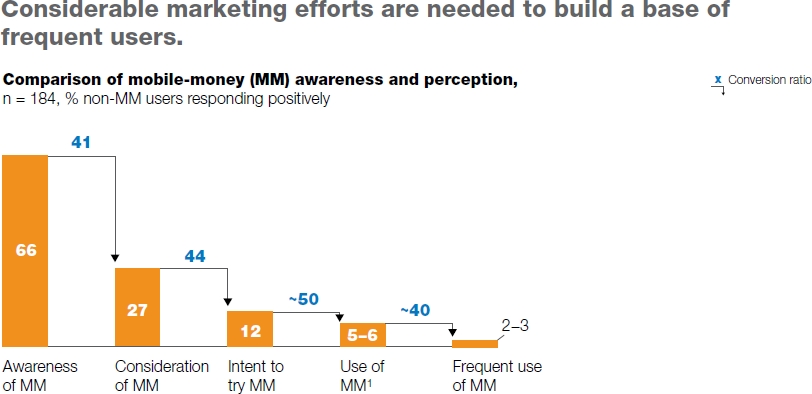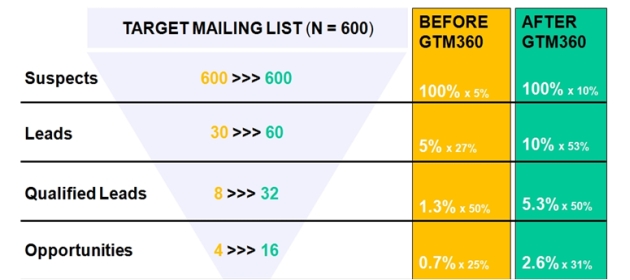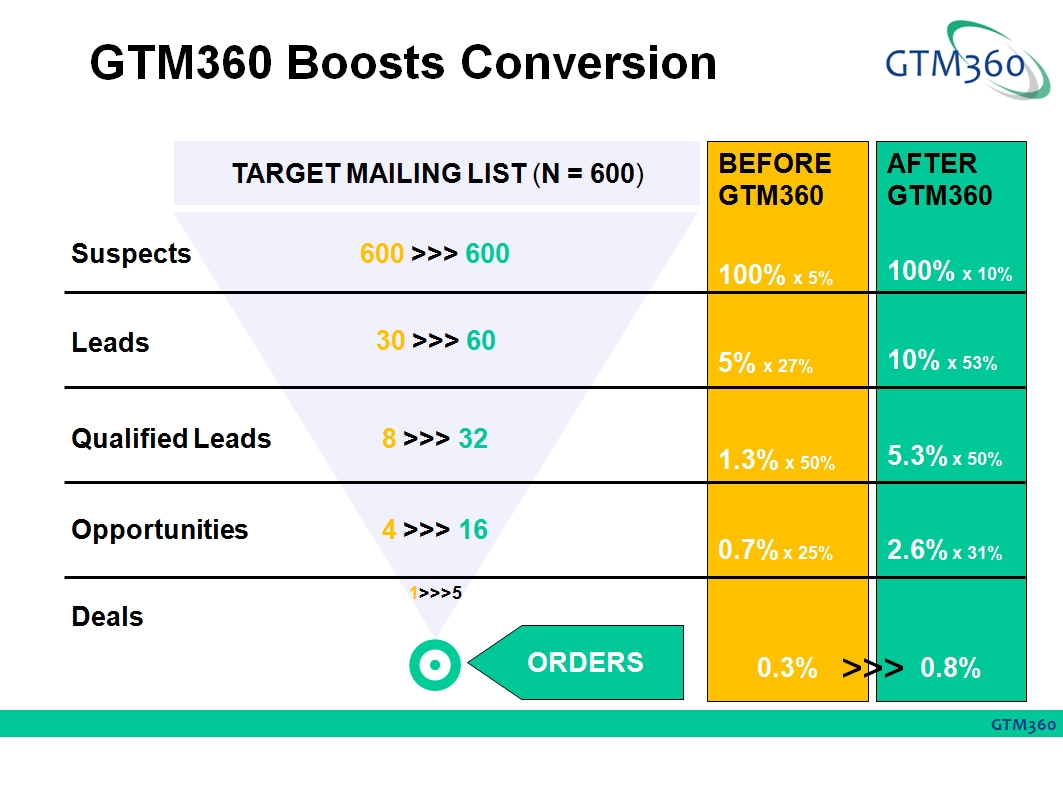Half the money I spend on advertising is wasted; the trouble is I don’t know which half.
This famous quote is attributed to John Wanamaker (1838-1922), the US businessman who is often considered to be the father of the department store.
We use the slide at the bottom to explain the impact of our go to market solutions on IT and other high-tech companies, who comprise our primary target market.
When seasoned sales and marketing professionals hear that our intervention can improve conversion from ~0.1-0.3% to ~0.8-1%, they’re excited about the 3-5X increase we drive in market outreach, geographical presence, sales pipeline, billing rates and ticket sizes, and they want to dig deeper into how we manage to deliver that kind of uplift in these metrics.
However, when the uninitiated see the same 1% figure, their reaction is different: Some of them ask us why the heck they should waste time pursuing the 99% of the market that’s anyway not going to buy from them. Others start wondering if they can use a totally random approach to get such a ‘miniscule’ conversion.
One the face of it, these are genuine concerns.
By deploying 50 programmers for two months, a software company will be able to develop an app requiring 100 person months. Founders coming from an engineering background tend to assume that there is a similar one-to-one relationship between input and output in other activities of their company.
Sadly, that “efficiency” mindset does not work in sales and marketing (which is governed more by “effectiveness” considerations).
That’s because you will get your app no matter what your competitor does. Even if he’s working in parallel on developing a similar app, it does not affect you. As long as you deploy 50 programmers for two months and manage them reasonably well, you will get your app. Your output is not impacted by your competitor’s actions.
That’s not the case in sales and marketing.
If your sales makes 100 calls to land 5 deals today, that strike rate will go for a toss if a competitor enters the fray tomorrow and also makes 100 calls to the same set of propective customers.
The important point to note is,
Customer acquisition is a zero sum game whereas software development is not.
https://twitter.com/Julian/status/1207013822793314305
That’s why you never get a straightforward translation of efforts to results in sales and marketing. Your input-output ratio is subject to competition and other external factors that are beyond your control. That’s not at all the case in an internal function like software development.
In B2B technology, your customers are not holding a placard announcing their intention to buy from you. So you need to comb the entire market before you can land the the 1% fraction of your customers who will eventually buy from you and move them from one stage of the funnel to the other.
To do that in a predictable and scaleable manner, you need to follow a structured approach, comprising several steps. This will likely yield 1% conversion rate.
Now, if you use a coin toss, you’ll get 50% success at each step but, over a process with 10 steps, you’ll get only 0.097% conversion rate (being 0.5*0.5*0.5*0.5*0.5*0.5*0.5*0.5*0.5*0.5).
To recap, a structured methodology will yield 1% conversion whereas a coin toss will yield only 0.1% conversion. So a structured methodology has 10X better performance than random methodology.
Now let’s take the top two stages of the sales funnel illustrated above. These are called ‘Suspects’ and ‘Leads’. Suspects are companies to which you’ve reached out via email, telephone or some other channel. After hearing from you, some of those suspects “raise their hands” to show interest in what you offer and, accordingly, become your Leads. The goal of the salesperson or marketer is to reach out to maximum number of suspects and convert as many of them to leads as possible.
Unfortunately for you, your competitors are also doing exactly the same. So it’s not only you.
To cite an example, a large European bank told us recently that they were contacted by around 50 IT vendors in a typical week, of which they spare the time to meet only one. As one among those 50 companies, you can’t secure that much-prized appointment by taking a random approach. Only the vendor that has followed a systematic approach to craft its message and convey it will win.
B2B marketers can take consolation that low conversion rate is not unique to their industry. Some other businesses afflicted with it are
- Drug discovery
- Amazon / Flipkart visitor-to-customer conversion
- Google Ads CTR
- Gold mining
- Ideas to implementation
- VC-funded startups
- Freemium-to-Paid conversion for media, streaming video, SAAS / apps.
TrueCaller Vital Stats (India):
* Total Users: 150M
of which
*Paid Users: 720K i.e. only 0.48% .
~ https://t.co/FgpccEjlOB via @medianama ."Extremely Underwhelming Performance" OR "Huge Headroom for Growth"?
You decide.
— Ketharaman Swaminathan (@s_ketharaman) June 23, 2020
 Just as none of these activities can be done haphazardly, neither can you follow a “spray-and-pray” approach when it comes to marketing. Go to market requires a structured methodology, which, in our case, spans four phases namely, offering, content, campaign and sales support.
Just as none of these activities can be done haphazardly, neither can you follow a “spray-and-pray” approach when it comes to marketing. Go to market requires a structured methodology, which, in our case, spans four phases namely, offering, content, campaign and sales support.
Now that you’ve accepted the need for a structured methodology to achieve 1% conversion, you might wonder if it’s worth going through so much trouble to get there.
Well, that really depends on the size of your Total Addressable Market (TAM).
If the TAM is large enough, you can get huge returns even with just 1% conversion.
Let’s take a few examples.
#1. FLIPKART / ECOMMERCE
The Indian ecommerce company Flipkart attracts a daily traffic of 5.2M page views (Source: FreeWebsite Report). According to this Forbes India article, Flipkart generates around 17,500 sales a day, which translates to a conversion rate of 0.34% (17500/5.2M*100%). Even taking 50K, the higher figure for transactions per day reported by the FORTUNE magazine a few months ago but missing from its online version, the conversion works out to 0.96% (50000/5.2M*100%). Either way, Flipkart’s conversion is less than 1%, but, despite that, it happens to be India’s largest ecommerce company.
#2. M-PESA / MOBILE PAYMENT
 Take a look at M-PESA’s conversion funnel shown on the right. The conversion rate is ‘only’ 1.08% (2/184*100%). Despite that, M-PESA has become one of the the world’s most successful mobile payment service (Source: McKinsey).
Take a look at M-PESA’s conversion funnel shown on the right. The conversion rate is ‘only’ 1.08% (2/184*100%). Despite that, M-PESA has become one of the the world’s most successful mobile payment service (Source: McKinsey).
#3. GOOGLE ADS / DIGITAL MARKETING
The average clickthrough rate of a Google Ad is 2%. In other words, 98 out of 100 Google Ads are not clicked aka “wasted”. Still Google Ads is the most popular digital advertising platform in the world. Its effectiveness – not efficiency – has made it one of the five most valuable companies on the planet.
Have Flipkart, M-PESA and Google Ads achieved their respective leadership positions by fluke?
Certainly not.
So is workout advice.
Pro sports is an exceptions business too. Elite athletes don’t become exceptions without doing the basics.
VC advice is the equivalent of physical training advice. It won’t make you exceptional but it can keep you from self sabotage.
— winfield.eth ????? (@kirbywinfield) July 27, 2020
You can’t achieve even 1% conversion rate by tossing a coin.
That’s why, despite complaining that only 50% of advertising works for a century, companies and brands still spend a lot of money on advertising. In fact, ad spends have increased by leaps and bounds during the century following Wanamaker’s famous statement.
“Half my advertising works; I don’t care which half.”
– "Ketharaman’s Wanamaker Rebuttal"https://t.co/ercGq1dYfD— GTM360 (@GTM360) April 17, 2018
Likewise, in the B2B technology space, even when only one out of the 100 companies you’ve touched becomes your customer, you’ll earn enough revenue to pay back your marketing investment many times over.
In a nutshell, 100% conversion is impossible but a random approach won’t even yield a 1% conversion rate.
On a side note, this is yet another manifestation of the “Effectiveness v. Efficiency” debate.
Metrics like Return on Marketing Investment (ROMI) and Return on Ad Spend (ROAS) reflect Effectiveness.
Metrics like Click Through Rate (CTR), Visitor-to-Lead, Lead-to-Deal reflect Efficiency.
As in many other things in marketing, it’s not a question of “this” or “that”. Both Effectiveness and Efficiency are important, just at different stages of GTM.
When you have a choice of various channels such as SEM, SEO and SMM, and the budget to spend on only one of them, go by ROMI – select the channel with the highest ROMI.
After selecting that channel (say SEM), use Conversion Rate Optimization techniques to improve conversion rate metrics. As you can see here and here, we’ve helped several companies achieve manifold increase in conversion of website visitors to leads / deals.

